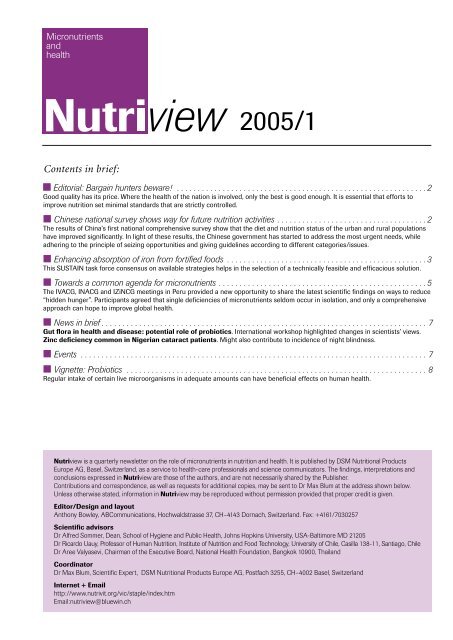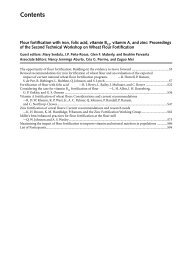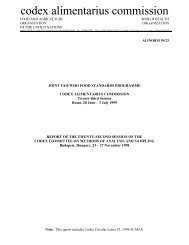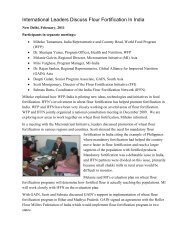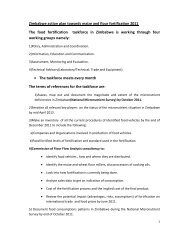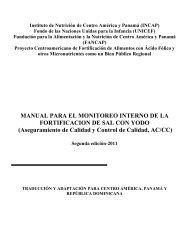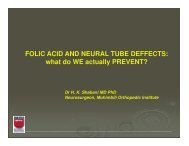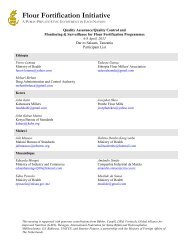Nutriview - Flour Fortification Initiative
Nutriview - Flour Fortification Initiative
Nutriview - Flour Fortification Initiative
Create successful ePaper yourself
Turn your PDF publications into a flip-book with our unique Google optimized e-Paper software.
2005/1<br />
Contents in brief:<br />
Editorial: Bargain hunters beware! . . . . . . . . . . . . . . . . . . . . . . . . . . . . . . . . . . . . . . . . . . . . . . . . . . . . . . . . . . . . 2<br />
Good quality has its price. Where the health of the nation is involved, only the best is good enough. It is essential that efforts to<br />
improve nutrition set minimal standards that are strictly controlled.<br />
■ Chinese national survey shows way for future nutrition activities . . . . . . . . . . . . . . . . . . . . . . . . . . . . . . . . . . . . 2<br />
The results of China’s first national comprehensive survey show that the diet and nutrition status of the urban and rural populations<br />
have improved significantly. In light of these results, the Chinese government has started to address the most urgent needs, while<br />
adhering to the principle of seizing opportunities and giving guidelines according to different categories/issues.<br />
■ Enhancing absorption of iron from fortified foods . . . . . . . . . . . . . . . . . . . . . . . . . . . . . . . . . . . . . . . . . . . . . . . . 3<br />
This SUSTAIN task force consensus on available strategies helps in the selection of a technically feasible and efficacious solution.<br />
■ Towards a common agenda for micronutrients . . . . . . . . . . . . . . . . . . . . . . . . . . . . . . . . . . . . . . . . . . . . . . . . . . 5<br />
The IVACG, INACG and IZiNCG meetings in Peru provided a new opportunity to share the latest scientific findings on ways to reduce<br />
“hidden hunger”. Participants agreed that single deficiencies of micronutrients seldom occur in isolation, and only a comprehensive<br />
approach can hope to improve global health.<br />
■ News in brief . . . . . . . . . . . . . . . . . . . . . . . . . . . . . . . . . . . . . . . . . . . . . . . . . . . . . . . . . . . . . . . . . . . . . . . . . . . . . . 7<br />
Gut flora in health and disease: potential role of probiotics. International workshop highlighted changes in scientists’ views.<br />
Zinc deficiency common in Nigerian cataract patients. Might also contribute to incidence of night blindness.<br />
■ Events . . . . . . . . . . . . . . . . . . . . . . . . . . . . . . . . . . . . . . . . . . . . . . . . . . . . . . . . . . . . . . . . . . . . . . . . . . . . . . . . . . . 7<br />
■ Vignette: Probiotics . . . . . . . . . . . . . . . . . . . . . . . . . . . . . . . . . . . . . . . . . . . . . . . . . . . . . . . . . . . . . . . . . . . . . . . . 8<br />
Regular intake of certain live microorganisms in adequate amounts can have beneficial effects on human health.<br />
<strong>Nutriview</strong> is a quarterly newsletter on the role of micronutrients in nutrition and health. It is published by DSM Nutritional Products<br />
Europe AG, Basel, Switzerland, as a service to health-care professionals and science communicators. The findings, interpretations and<br />
conclusions expressed in <strong>Nutriview</strong> are those of the authors, and are not necessarily shared by the Publisher.<br />
Contributions and correspondence, as well as requests for additional copies, may be sent to Dr Max Blum at the address shown below.<br />
Unless otherwise stated, information in <strong>Nutriview</strong> may be reproduced without permission provided that proper credit is given.<br />
Editor/Design and layout<br />
Anthony Bowley, ABCommunications, Hochwaldstrasse 37, CH–4143 Dornach, Switzerland. Fax: +4161/7030257<br />
Scientific advisors<br />
Dr Alfred Sommer, Dean, School of Hygiene and Public Health, Johns Hopkins University, USA-Baltimore MD 21205<br />
Dr Ricardo Uauy, Professor of Human Nutrition, Institute of Nutrition and Food Technology, University of Chile, Casilla 138-11, Santiago, Chile<br />
Dr Aree Valyasevi, Chairman of the Executive Board, National Health Foundation, Bangkok 10900, Thailand<br />
Coordinator<br />
Dr Max Blum, Scientific Expert, DSM Nutritional Products Europe AG, Postfach 3255, CH–4002 Basel, Switzerland<br />
Internet + Email<br />
http://www.nutrivit.org/vic/staple/index.htm<br />
Email:nutriview@bluewin.ch
<strong>Nutriview</strong> 2005/1 2<br />
■ Editorial:<br />
Bargain hunters beware!<br />
When criminal manufacturers flood the<br />
market with cheap copies of luxury goods,<br />
such as jewelry, watches and designer<br />
clothes, you might be inclined to shrug<br />
your shoulders, thinking that nobody<br />
suffers. People usually know they are<br />
buying a counterfeit, and would probably<br />
be unwilling or unable to pay the price<br />
asked for the original, anyway.<br />
It is a different matter, however, when<br />
shopping for food. We expect it to be safe,<br />
nutritious and reasonably priced. Often we<br />
associate these qualities with a particular<br />
brand name. As ordinary consumers, we<br />
are seldom able to identify inferior quality<br />
food products on the supermarket shelf.<br />
So we rely on our country’s regulatory<br />
system, and the honesty and experience<br />
of the retailer to give us what we expect.<br />
Unfortunately, it is all too easy for<br />
unscrupulous manufacturers to fool the<br />
system, at least some of the time. Even<br />
sophisticated markets in North America<br />
and Europe are not immune, and need to<br />
keep a watchful eye on developments.<br />
In most cases, the inferior products<br />
are identified sooner or later without any<br />
major damage being done to consumers’<br />
health. But it would be wrong to treat<br />
such matters complacently. In 2004, the<br />
Chinese authorities had a major scandal<br />
on their hands after 50 infants fed a fake<br />
baby milk powder died, and hundreds of<br />
others suffered acute malnutrition. The<br />
affected families were among the poorest<br />
section of the population, who thought<br />
the product was a good bargain, because<br />
of its low price.<br />
With the growing pressure on manufacturers<br />
in developing countries to<br />
improve the nutritional value of their<br />
products through fortification, it is also<br />
becoming increasingly important for them<br />
to be sure they can trust their premix<br />
supplier. In Nigeria, for example, several<br />
manufacturers, in an effort to minimize<br />
expenses, planned to use a vitamin and<br />
mineral premix that was offered to them<br />
at a surprisingly competitive price. The<br />
authorities discovered that this premix fell<br />
short of the required specifications, and<br />
so were able to prevent a serious setback<br />
in the country’s nutrition efforts.<br />
What we can learn from such experiences<br />
is that good quality has its price,<br />
and, where the health of the nation is<br />
involved, only the best is good enough.<br />
It is essential that efforts to improve<br />
nutrition set minimal standards that are<br />
strictly controlled. – A. Bowley ■<br />
■ Feature:<br />
Chinese national survey shows way for future nutrition activities<br />
On October 12, 2004, Wang Longde,<br />
Vice Minister at the Chinese Ministry of<br />
Health, presented the results of China’s first<br />
national comprehensive survey ever that<br />
covered diet, nutrition and hypertension,<br />
diabetes, obesity and abnormal blood lipid<br />
levels. This survey, which was conducted<br />
from August to December 2002 under the<br />
joint leadership of the Ministry of Health,<br />
the Ministry of Science and Technology<br />
and the National Bureau of Statistics, has<br />
basically collected the information relating<br />
to the Chinese people’s diet, nutrition<br />
and disease conditions, and by this it has<br />
provided the government with scientific<br />
and reliable evidence to formulate relevant<br />
policies and development plans<br />
for the future.<br />
The results of this survey show that with<br />
the sustained and rapid economic development<br />
in China, the diet and nutrition status<br />
of the urban and rural populations have<br />
improved significantly, and the prevalence<br />
of malnutrition and nutrition deficiencies<br />
has decreased. In the meantime, however,<br />
China is also facing the dual challenges<br />
of nutrition deficiency and nutrition<br />
imbalance. Generally speaking, energy<br />
and protein intakes of the urban and rural<br />
residents are basically satisfactory, and<br />
there has been a significant increase in the<br />
consumption of meat, eggs and poultry,<br />
with an increase in good quality protein.<br />
Compared with 1992, the diets of the<br />
rural population in China have changed<br />
significantly and their dietary patterns<br />
have become more reasonable.<br />
The growth of children and teenagers<br />
has improved steadily. Average infant<br />
birth weight was 3,309 grams, with low<br />
birth weight occurring in only 3.6% of<br />
cases, (a level similar to that found in<br />
industrialized countries). Growth retardation<br />
in children under 5 years was 14.3%,<br />
which marks a 55% decrease compared<br />
with 1992. Prevalence of low body weight<br />
in children was 7.8%, a decrease of 57%<br />
compared with the figure in 1992. Prevalence<br />
of malnutrition among children has<br />
decreased. However, in the poorer areas,<br />
29.3% of children under 5 years show<br />
growth retardation and 14.4% have a<br />
low body weight. In addition, insufficient<br />
intakes of calcium, iron, vitamin A as<br />
well as other micronutrients remain a<br />
common problem in both urban and<br />
rural areas.<br />
The prevalence of anemia among the<br />
Chinese people averaged 15.2% (24.2%<br />
among infants and children under two<br />
years; 21.5% in people over 60 years, and<br />
20.6% among women of child-bearing age).<br />
The prevalence of vitamin A deficiency<br />
in children was 9.3%; the prevalence of<br />
marginal vitamin A deficiency was 45.1%.<br />
The average calcium intake among the<br />
urban and the rural populations was<br />
only 391 mg, (41% of the recommended<br />
intake).<br />
Chronic disease risk increasing<br />
The main issues for concern in the nutrition<br />
and health status of Chinese people<br />
are the high dietary energy and fat intakes,<br />
and the low levels of physical activity.<br />
These are closely related to overweight,<br />
obesity, diabetes and abnormal blood<br />
lipid levels.
3 <strong>Nutriview</strong> 2005/1<br />
The prevalence of hypertension among<br />
adults in China was 18.8%. This means that<br />
about 160 million people in the country<br />
are suffering from high blood pressure, an<br />
increase of more than 70 million people<br />
compared with 1991. There is now no<br />
significant difference between urban and<br />
the rural areas in the prevalence of hypertension.<br />
The survey results indicate that<br />
the risk of hypertension is closely related<br />
to high salt intake and alcohol drinking.<br />
The prevalence of diabetes among adults<br />
was 2.6% (meaning that more than 20<br />
million people in China are suffering from<br />
diabetes), and the prevalence of abnormal<br />
blood lipid levels was 18.6%.<br />
Two hundred million Chinese adults<br />
are overweight (22.8%) and over 60 million<br />
are obese (7.1%). In big cities, the<br />
prevalence of overweight and obesity<br />
are 30.0% and 12.3% respectively. The<br />
prevalence of obesity among children<br />
has reached 8.1%. This requires greater<br />
attention. Compared with the nutrition<br />
survey results of 1992, the prevalence of<br />
overweight and obesity have increased by<br />
39% and 97% respectively.<br />
Proposed actions and measures<br />
In light of the results from this survey, the<br />
Chinese government has started to address<br />
the most urgent needs, while adhering to<br />
the principle of seizing the opportunities<br />
and giving guidelines according to different<br />
categories/issues. It will consolidate<br />
its work to improve people’s nutrition<br />
status and to control and prevent chronic<br />
diseases through policy support, market<br />
guidance and mass education.<br />
To strengthen government leadership<br />
it will expedite relevant laws and regulations<br />
and integrate the improvement of<br />
people’s nutrition and health into the 11th<br />
Five Year Development Plans at national<br />
and local levels.<br />
It will consolidate scientific guidance in<br />
the fields of agriculture, food manufacturing,<br />
distribution and marketing, and<br />
bring into play their important roles in<br />
improving people’s nutrition and health<br />
status.<br />
It will strengthen public education,<br />
advocate a balanced diet and healthy lifestyles,<br />
and enhance people’s awareness and<br />
capabilities for self-health protection.<br />
In order to make full use of the information<br />
derived from this survey, relevant<br />
government ministries, commissions and<br />
agencies will be organized to prepare and<br />
publish the white paper on the Chinese<br />
people’s nutrition and health status, and a<br />
series of monograph and popular scientific<br />
books. The survey database will be open<br />
to the public and information sharing<br />
will be realized.<br />
■<br />
Source: Press Release by State Council<br />
Information Office, October 12, 2004,<br />
Beijing.<br />
■ Feature:<br />
Enhancing absorption of iron from fortified foods<br />
Iron deficiency remains a major global<br />
health problem affecting some two billion<br />
people. In 2002, the World Health<br />
Organization ranked it 7th among the<br />
preventable risks for disease, disability<br />
and death. Efforts to eliminate iron<br />
deficiency through dietary diversification<br />
(promoting consumption of ironrich<br />
foods) is hindered by the difficulty<br />
in achieving behavioral change as well<br />
as by the predominance in developing<br />
countries of plant-based diets deficient in<br />
the more bioavailable heme form of iron.<br />
Supplementation interventions have been<br />
mainly targeted at high-risk groups such<br />
as pregnant women and young children.<br />
They often fail due to lack of compliance<br />
following adverse effects from the high<br />
doses used or because of supply/distribution<br />
problems.<br />
<strong>Fortification</strong> of staples such as wheat<br />
and maize flour, or condiments such as<br />
salt, fish sauce or soy sauce offers a more<br />
cost-effective approach to providing<br />
additional iron to most segments of the<br />
population. Infants and young children<br />
can be specifically targeted through fortified<br />
infant formulas and cereal-based<br />
complementary foods. A major technical<br />
barrier that remains, particularly for cereal<br />
flours and salt, is to find an iron compound<br />
that is sufficiently bioavailable but does<br />
not cause adverse sensory changes to the<br />
food vehicle. Another barrier to successful<br />
food fortification is the inhibitory effect<br />
of dietary components such as phytate,<br />
phenolic compounds and calcium, which<br />
can prevent acceptable amounts of iron<br />
absorption even from compounds such<br />
as ferrous sulfate.<br />
To address these barriers, and to assess<br />
the different strategies available, SUSTAIN<br />
set up a Task Force consisting of nutritional,<br />
medical, industry and government experts.<br />
This task force reviewed successful iron<br />
fortification programs, and summarized<br />
the key issues in relation to each of the<br />
iron absorption enhancers, emphasizing<br />
the relevance to finished food staples and<br />
widely consumed condiments. Following<br />
discussions at a workshop held in Washington,<br />
DC, in March 2003 (Workshop<br />
on Innovative Ingredient Technologies to<br />
Enhance Iron Absorption), and subsequent<br />
consultations with other experts from<br />
industry, government and the scientific<br />
community, the task force has formulated<br />
a consensus statement on each of<br />
the strategies under consideration. The<br />
main points of this consensus statement<br />
are summarized in Table 1.<br />
Ascorbic acid, NaFeEDTA, ferrous bisglycinate,<br />
and dephytinization all enhance<br />
the absorption of fortification iron, but<br />
add to the overall costs of fortification.<br />
While every strategy cannot be recommended<br />
for all food fortification vehicles,<br />
individual strategies can be recommended<br />
for specific foods. With further development,<br />
dephytinization could become an<br />
alternative for low-cost cereal-based foods<br />
in developing countries. Encapsulation<br />
of iron salts in lipid coatings, while not<br />
an iron absorption-enhancing strategy in<br />
itself, can prevent soluble forms of iron<br />
from interacting undesirably with some<br />
food vehicles and hence broaden the<br />
application of some fortificants.
<strong>Nutriview</strong> 2005/1 4<br />
Table 1: SUSTAIN consensus on choice of iron enhancing technology for fortified foods<br />
Strategy Suitability Effect Limitations Relative cost*<br />
Ascorbic acid<br />
Other organic acids<br />
(e.g. citric, lactic, tartaric<br />
acids)<br />
Iron EDTA chelates<br />
(NaFeEDTA)<br />
Amino acid chelates<br />
(e.g. ferrous bisglycinate)<br />
Phytate degradation<br />
Microencapsulation<br />
of ferrous sulfate/ferrous<br />
fumarate in oil<br />
Dry products (e.g. powdered<br />
milk, precooked<br />
infant foods). Effective<br />
in molar ratio 2:1 (low<br />
phytate content) to 4:1<br />
(high phytate content).<br />
Fruit drinks. Effective<br />
only at high molar<br />
ratios (>100:1 acid:iron).<br />
Soy and fish sauce;<br />
condiments;<br />
high-phytate flours.<br />
No adverse effect on<br />
metabolism of other<br />
nutritionally important<br />
metals.<br />
Milk and beverages.<br />
Cereal- and legumebased<br />
weaning foods.<br />
Dry products stored at<br />
low temperatures (e.g.<br />
infant foods, condiments,<br />
“sprinkles”).<br />
2–3x dose-dependent<br />
increase in iron absorption<br />
(intrinsic and added<br />
iron)<br />
Iron bioavailability from<br />
high-phytate meals 2–3<br />
times higher than with<br />
ferrous sulfate.<br />
Iron bioavailability from<br />
bread and milk 2–3 times<br />
higher than with ferrous<br />
sulfate.<br />
Complete phytate removal<br />
can improve iron absorption<br />
2–12 fold.<br />
Resolves sensory and<br />
stability issues that limit<br />
addition of soluble iron<br />
forms to foods. May protect<br />
against oxidation.<br />
Instability in aqueous solutions<br />
and during prolonged heat processing.<br />
Needs packaging that<br />
excludes oxygen.<br />
Cause unacceptable flavor<br />
changes in most foods<br />
Ambiguous regulatory status.<br />
Not recommended for infant<br />
foods. Packaging needs to<br />
protect EDTA against UV<br />
degradation.<br />
Additional research on stability<br />
and organoleptic effects needed.<br />
5.0–7.0<br />
4.6–14.8<br />
Further research needed. 7.1–18.5<br />
Requires near-complete removal<br />
of phytate to work.<br />
Food preparation involving heat<br />
may melt the capsule material<br />
and result in unacceptable<br />
organoleptic changes.<br />
See footnote**<br />
2.15–8.4<br />
* This calculation is based on the cost of a fortification strategy expected to the have same impact on iron status as 10 mg ferrous sulfate<br />
used alone (relative cost = 1.0). The comparison to ferrous sulfate was made because it is a commonly used iron fortificant, not<br />
because it is necessarily the preferred choice. The use of different enhancers is food-product specific, so this analysis should not be<br />
used to rank enhancers or make direct comparisons between an enhancer and ferrous sulfate. It only indicates the relative cost of<br />
the enhancer when used in an appropriate food vehicle.<br />
** The SUSTAIN analysis suggests that commercial phytate removal from flour would be expensive when compared with other<br />
enhancing technologies (estimate based on medium-to-high-volume production with prolonged processing at controlled temperature,<br />
ten years’ depreciation on capital expenditure and labor costs, as well as cost of the degradation agent). Other approaches,<br />
such as soaking and germination, fermentation, and addition of phytase to ready-to-eat foods (for activation during digestion) might<br />
be more economical, but were not taken into consideration for this calculation.<br />
Effective fortification depends on the<br />
selection of technically feasible and efficacious<br />
strategies. Once suitable strategies<br />
have been identified cost becomes very<br />
important in selecting the best approach<br />
to implement. However it is essential to<br />
calculate cost in relation to the amount<br />
of bioavailable iron delivered. ■<br />
This information is taken from the 2004<br />
SUSTAIN Task Force Report: “Enhancing the<br />
Absorption of <strong>Fortification</strong> Iron”. Members<br />
of the Task force are: Richard Hurrell 1 , Sean<br />
Lynch 2 , Thomas Bothwell 3 , Héctor Cori 4 , Ray<br />
Glahn 5 , Eva Hertrampf 6 , Zdenek Kratky 7 ,<br />
Dennis Miller 8 , Mario Rodenstein 9 , Hugo<br />
Streekstra 10 , Birgit Teucher 11 , Elizabeth<br />
Turner 12 , C. K. Yeung 8 , Michael Zimmermann 1<br />
1<br />
Institute of Food Science and Nutrition,<br />
Swiss Federal Institute of Technology<br />
Zurich, Switzerland; 2 Eastern Virginia<br />
Medical School, Norfolk, Virginia, USA;<br />
3<br />
Department of Medicine, University of<br />
Witwatersrand, Johannesburg, South Africa;<br />
4<br />
DSM Nutritional Products, Santiago, Chile;<br />
5<br />
USDA-ARS Plant Soil and Nutrition<br />
Laboratory, Ithaca, New York, USA; 6<br />
Institute of Nutrition and Food Technology,<br />
Santiago, Chile; 7 Nestlé, New Milford,<br />
Connecticut, USA; 8 Department of Food<br />
Science, Cornell University, Ithaca, New<br />
York, USA; 9 Unilever, Englewood Cliffs,<br />
New Jersey, USA; 10 DSM Food Specialties,<br />
Delft, Netherlands; 11 Institute of Food<br />
Research, Norwich Laboratory, Norwich,<br />
UK; 12 SUSTAIN, Washington, DC, USA.
5 <strong>Nutriview</strong> 2005/1<br />
■ Conference report:<br />
Towards a common agenda for micronutrients<br />
From 15 to 19 November 2004 more than<br />
665 policy makers, program managers,<br />
planners, and scientists from 79 countries<br />
met in Lima, Peru, to discuss ways to<br />
improve the micronutrient status of infants,<br />
children and women of childbearing age<br />
in developing countries. The meetings<br />
were hosted by the International Vitamin<br />
A Consultative Group (IVACG; its 22nd<br />
meeting), the International Nutritional<br />
Anemia Consultative Group (INACG; its<br />
4th symposium), and the International Zinc<br />
Nutrition Consultative Group (IZiNCG;<br />
its 3rd symposium) and coordinated by<br />
the Peruvian Ministry of Health, the Pan<br />
American Health Organization, USAID/<br />
Peru and nongovernmental organizations<br />
in Peru. Additional funding was provided<br />
by the Task Force SIGHT AND LIFE,<br />
the Micronutrient <strong>Initiative</strong> and several<br />
private sector companies. UNICEF and<br />
the International Zinc Association also<br />
contributed to the support of the IZiNCG<br />
symposium.<br />
The panel at the opening session in Lima (second from the right: Dr Pilar Mazzetti Soler, Minister<br />
of Health of Peru)<br />
Watchwords urged for global<br />
health<br />
Dr Pilar Mazzetti Soler, Minister of<br />
Health of Peru, opened the IVACG meeting,<br />
acknowledging that it provided an<br />
opportunity to share the latest scientific<br />
findings on ways to reduce “hidden hunger”<br />
in women and children worldwide. Vitamin<br />
A deficiency (VAD), which is only one<br />
component of “hidden hunger,” affects<br />
approximately 127 million preschool children<br />
worldwide. According to Dr Richard<br />
Martin, Office of Health Director at the<br />
US Agency for International Development<br />
(USAID), reducing VAD is an excellent<br />
investment for developing countries.<br />
He congratulated IVACG for providing<br />
a forum to exchange data on how to do<br />
this effectively.<br />
In the keynote address, Dr Gerald Keusch,<br />
Associate Dean for Global Health at Boston<br />
University School of Public Health, urged<br />
collaboration, integrity and action as the<br />
watchwords for achieving global health in<br />
a globalized world. Since micronutrients<br />
are only one piece of the public health<br />
puzzle, Dr Keusch encouraged partnership<br />
across disciplines to achieve public<br />
health action. Nutrition, especially with<br />
micronutrients, is a conditioning factor for<br />
infectious disease mortality and morbidity.<br />
To control these, better integration<br />
of micronutrient and infectious disease<br />
programs is vital.<br />
A choice of food-based approaches<br />
Efforts to improve dietary quality through<br />
home gardening and animal husbandry<br />
continue. As well as increasing intakes of<br />
micronutrient-rich foods such as meat, fish,<br />
eggs and dairy produce, such programs<br />
can help to combat poverty by generating<br />
income. Others are looking at ways to<br />
increase beta-carotene intakes by promoting<br />
consumption of beta-carotene-rich<br />
indigenous vegetables, by limiting losses<br />
during storage, and by developing new<br />
crop varieties (e.g. ‘golden rice’) and eggs<br />
with a higher beta-carotene content.<br />
Because populations with VAD are likely<br />
to be deficient in other micronutrients as<br />
well, researchers have begun to explore<br />
the benefits and complications of combining<br />
micronutrients. An encouraging<br />
new technology is triple fortification<br />
of salt with microencapsulated iodine,<br />
iron and vitamin A. Microencapsulation<br />
(in hydrogenated oil) appears to<br />
improve stability as well as ensuring an<br />
adequate bioavailability. Nevertheless,<br />
more research is still needed to reach an<br />
optimal solution.<br />
Screening for deficient populations<br />
Methods to determine vitamin A status<br />
are becoming increasingly sophisticated.<br />
Among the methods discussed at the<br />
meeting were the modified relative dose<br />
response (MRDR), retinol binding protein,<br />
blood spot retinol, stable isotope methods<br />
and dark adaptation. Dried blood<br />
spot methods are ideal for developing<br />
countries because samples are easy to<br />
collect and do not require centrifuging<br />
or freezing.<br />
When screening for VAD, it is important<br />
to take into account the suppressive<br />
effect of infection on retinol levels.<br />
Vitamin A concentrations are also lower<br />
during pregnancy, especially in the third<br />
trimester.<br />
Multiple supplementation<br />
desirable<br />
It is becoming increasingly clear that VAD<br />
seldom occurs in isolation, and several<br />
speakers showed that multiple micronutrient<br />
supplementation can help to correct<br />
other limiting deficiencies affecting<br />
maternal and infant health.<br />
Several presentations highlighted<br />
national vitamin A supplementation<br />
programs that successfully replaced<br />
National Immunization Days (NIDS)<br />
with alternative supplement delivery<br />
strategies. Developing these strategies<br />
continues to be a major focus of discussion<br />
and planning.<br />
Dr Alfred Sommer, Chair of the IVACG<br />
Steering Committee, closed the threeday<br />
meeting, saying it was gratifying to
<strong>Nutriview</strong> 2005/1 6<br />
hear that real progress is being made in<br />
developing enriched cultivars of staple<br />
foods through traditional breeding and<br />
genetic engineering.<br />
Iron deficiency in early life:<br />
challenges and progress<br />
Opening the INACG Symposium on<br />
November 18, Dr Frances Davidson,<br />
Global Health Bureau, Office of Health,<br />
Infectious Disease and Nutrition, USAID,<br />
called attention to INACG’s focus on<br />
state-of-the-art research and innovative<br />
programming for the most vulnerable<br />
populations: infants, children and<br />
pregnant women. Data from Zanzibar<br />
suggest that children need to be protected<br />
against malaria (insecticide-treated nets<br />
and/or presumptive treatment) while<br />
taking iron/folic acid supplements. Given<br />
evidence that there may be some risk<br />
associated with iron supplementation of<br />
iron-replete children, further research<br />
is needed to evaluate the appropriate<br />
recommendations for universal iron/folic<br />
acid supplementation in malarious areas<br />
and potential strategies for targeting<br />
children who are iron-deficient. Studies<br />
from Asia and Africa presented at the<br />
symposium showed that fortification of<br />
staple foods and condiments with iron<br />
salts is a valid approach to reducing<br />
iron deficiency anemia in children and<br />
women at risk. Deworming and vitamin A<br />
supplementation also reduced anemia in<br />
children in Nepal. Dr Ian Darnton-Hill,<br />
Nutrition Section, UNICEF, was very<br />
optimistic about emerging strategies to<br />
combat anemia.<br />
Putting zinc into the agenda<br />
The IZiNCG Symposium on November<br />
19, entitled, “Moving zinc into the micronutrient<br />
program agenda”, provided new<br />
information on zinc and human function,<br />
examined recent experience in assessment<br />
of population zinc status in selected<br />
countries, and discussed results of recent<br />
interventions involving zinc supplementation<br />
and fortification. Recent studies have<br />
shown that zinc supplementation, when<br />
provided daily, reduces the incidence and<br />
severity of common infectious diseases of<br />
young children, including diarrhea and<br />
pneumonia. Several small-scale studies<br />
also found a reduction in mortality among<br />
zinc-supplemented children.<br />
Results from a recently completed trial<br />
in Bangladesh indicate that zinc supplementation<br />
provided just once weekly<br />
also reduces the incidence of pneumonia.<br />
A study conducted in South Africa to<br />
determine whether zinc supplements can<br />
be safely consumed by HIV-positive children<br />
found that the incidence of diarrhea<br />
was reduced among zinc-supplemented<br />
HIV-positive children and there were<br />
no differences between supplemented<br />
and control children with regard to the<br />
progression of HIV infection. Studies<br />
of the effect of zinc supplementation on<br />
children’s behavioral development have<br />
yielded inconsistent results. However, the<br />
outcomes of studies in Jamaica, India, and<br />
Guatemala suggest that zinc supplementation<br />
may improve general indicators of<br />
young children’s physical activity and<br />
exploratory behavior, both of which are<br />
likely to be important for the children’s<br />
future cognitive development.<br />
Investigators from Mexico and New<br />
Zealand presented examples of two successful<br />
large-scale surveys of population<br />
zinc status, which relied on dietary<br />
indicators of the risk of inadequate zinc<br />
intake and the distribution of serum zinc<br />
concentrations, as recommended in the<br />
recent IZiNCG report (Assessment of the<br />
risk of zinc deficiency in populations and<br />
options for its control. Hotz C, Brown<br />
KH (eds.). Food Nutr Bull 25: S94–S203,<br />
2004). Both surveys were useful to identify<br />
high-risk groups within the respective<br />
populations. The dietary studies in Mexico<br />
also provided valuable information on<br />
appropriate foods that should be considered<br />
for zinc fortification. During the<br />
discussion session, it was concluded that<br />
more assessment data are needed from<br />
other countries identified as having a<br />
likely high risk of zinc deficiency. To assist<br />
with this effort, additional information is<br />
needed on the zinc and phytate contents of<br />
local foods. Moreover, reference material<br />
and interlaboratory standardization are<br />
needed to improve the quality of serum<br />
zinc analyses.<br />
The new guidelines of the World Health<br />
Organization for the use of zinc supplements<br />
in the treatment of diarrhea (10–20<br />
mg zinc daily for 10–14 days along with<br />
oral rehydration solution; see <strong>Nutriview</strong><br />
2004/4 for details) were reviewed. To<br />
facilitate scaling up of diarrhea treatment<br />
programs, additional efforts and assistance<br />
are needed with regard to production and<br />
distribution of appropriate zinc tablets,<br />
training of health care professionals,<br />
formative research and social marketing,<br />
financing, and program evaluation.<br />
An analysis of previously completed trials<br />
in which zinc was provided either alone or<br />
with iron indicated that supplementation<br />
with zinc alone is safe and efficacious,<br />
although zinc may have a small negative<br />
impact on children’s final hemoglobin<br />
concentration. It is still uncertain whether<br />
iron may reduce the beneficial effect of<br />
zinc on major clinical outcomes.<br />
New information on the absorption<br />
of zinc from the two relatively low-cost<br />
zinc salts (zinc oxide and zinc sulfate)<br />
suggests that both forms are absorbed<br />
with similar efficiency from zinc-fortified<br />
wheat products, so either can be used<br />
in fortification programs. Efforts are<br />
underway to establish appropriate levels of<br />
zinc for fortification. Although evidence<br />
regarding the efficacy and effectiveness<br />
of zinc fortification programs is still<br />
incomplete, the strategy is considered safe<br />
and promising. IZiNCG looks forward to<br />
continued collaboration with the other<br />
micronutrient consultative groups and<br />
to assisting international agencies, governments<br />
and NGOs in their efforts to<br />
address the problem of zinc deficiency. ■<br />
Detailed reports of the IVACG/INACG<br />
meetings will be available in 2005<br />
from the ILSI Research Foundation,<br />
One Thomas Circle, NW, 9th Floor,<br />
Washington, DC 20005-5208, USA.<br />
Tel: 202-659-9024; fax: 202-659-3617;<br />
email: hni@ilsi.org. For more information<br />
on IZiNCG please consult the web<br />
site (http://www.izincg.ucdavis.edu).
7 <strong>Nutriview</strong> 2005/1<br />
■ News in brief:<br />
Gut flora in health and disease:<br />
potential role of probiotics<br />
The international workshop on probiotics<br />
that took place in Amsterdam last April<br />
[1] highlighted the revolutionary change<br />
in views on beneficial gut microbe-host<br />
interactions. During the workshop, 120<br />
experts from disciplines including human<br />
nutrition, gastroenterology, nutritional<br />
therapy, cell biology, microbiology and<br />
immunology discussed new views on<br />
microbe-host interactions and the role of<br />
probiotics in prevention and alleviation<br />
of gastrointestinal, atopic and autoimmune<br />
diseases.<br />
There was a general consensus among<br />
the experts that administering defined<br />
strains can help in preventing and curing<br />
diseases related to the gut flora. The first<br />
clinical trials show a promising role for<br />
probiotics, but the system is very complex,<br />
and most underlying mechanisms are<br />
still unclear.<br />
Rapid progress in this field will depend<br />
largely on the collaboration between<br />
fundamental researchers from different<br />
disciplines and medical specialists. In<br />
addition, more clinical studies are required<br />
to convince authorities and the public of<br />
the value of microbial therapies. ■<br />
1. First International Workshop on Probiotics.<br />
April 22–24, 2004, Amsterdam, the<br />
Netherlands<br />
Zinc deficiency common in<br />
Nigerian cataract patients<br />
Asonye et al.[1] randomly assessed zinc<br />
status and dietary zinc intake in 500<br />
men and women aged 60 years or older<br />
diagnosed with senile cataract, and 500<br />
matched controls, among patients attending<br />
eye clinics at teaching hospitals in<br />
midwestern Nigeria.<br />
Plasma zinc levels were below 1050 mg/L<br />
in 38% of patients with cataract and 17%<br />
of controls; 48% of cataract patients and<br />
21% of controls had a low dietary zinc<br />
intake. All the zinc deficient patients<br />
complained of prolonged dark adaptation<br />
and night blindness.<br />
Zinc deficiency may therefore be implicated<br />
in the high prevalence of cataract<br />
in developing countries. Additionally, it<br />
might contribute to the high incidence<br />
of night blindness in areas with high<br />
prevalence of vitamin A deficiency. ■<br />
1. Asonye CC, Akhideno JI, Agu GC. Assessment<br />
of plasma zinc status of senile cataract<br />
and non-cataract elderly patients in midwestern<br />
Nigeria- a case study of Edo and<br />
Delta States of Nigeria. AJFAND 2004; 2.<br />
<br />
■ Events:<br />
Seventh International Graduate<br />
Course on Production and<br />
Use of Food Composition<br />
Data in Nutrition. October<br />
31 – November 16, 2005,<br />
Wageningen, the Netherlands.<br />
This course is for those involved in food<br />
composition programs as analysts and/or<br />
compilers, and will be of value to those<br />
teaching nutrition and nutritional aspects<br />
of food chemistry.<br />
Aim: to show how the quality and<br />
usefulness of food composition data is<br />
determined by the quality of the production<br />
of analytical data for nutrients in<br />
foods, and the compilation of these and<br />
other data into food composition tables<br />
and nutritional databases.<br />
Applications should be submitted before<br />
June 1, 2005. Further details are available<br />
from: Ms L.A. Duym-Brookman, secretariat<br />
Foodcomp2005, Division of Human<br />
Nutrition, Wageningen University, P.O.<br />
Box 8129, NL-6700 EV Wageningen, the<br />
Netherlands. Tel. +31 317483054; email:<br />
lous.duym@wur.nl<br />
■<br />
Foods for the Healthy Elderly: Ripe<br />
for Growth. October 6–7, 2005,<br />
Amsterdam, the Netherlands.<br />
With a rapidly aging population in the<br />
western world, the market for the elderly<br />
is set to grow. This conference is aimed at<br />
R&D managers from the food and drinks<br />
industry, nutritionists, food technologists ,<br />
policy makers and others, and will discuss<br />
the latest developments regarding foods<br />
for the elderly, and help to provide an<br />
understanding of changing needs.<br />
Further details: Bastiaanse Communication,<br />
P.O. Box 179, NL-3720 AD Bilthoven.<br />
Tel. +31 302294247; email: FE@bastiaansecommunication.com<br />
■<br />
6th International Food Data<br />
Conference, Pretoria, South<br />
Africa, September 14–16, 2005<br />
Pre-ICN satellite meeting, organized by<br />
the Agricultural Research Council and the<br />
University of Pretoria, on food composition<br />
data and the nutrition dilemma.<br />
Further details: or Dr Louwrens<br />
Smit. Tel. +27 126651605; email:<br />
louwrens@irene.agric.za ■<br />
Second Pan-African Conference on<br />
Information and Communication<br />
Technology and Nutrition (ITANA).<br />
Cape Town, South Africa,<br />
September 16–18, 2005.<br />
This second ITANA congress, organized<br />
by the ITANA Nutrition e-Society and<br />
the University of Stellenbosch, is offered<br />
as an official Nutrition Safari of the 18th<br />
International Congress of Nutrition. It<br />
provides an opportunity for colleagues<br />
around the world to simultaneously focus<br />
on a niche area in nutrition and see another<br />
beautiful part of the host country.<br />
For further information contact: Mrs<br />
Ursula Petersen. Tel. +27 219389259; email:<br />
uap@sun.ac.za<br />
■<br />
18th IUNS International Congress<br />
of Nutrition, Durban, South Africa,<br />
September 19–23, 2005<br />
Theme: Nutrition Safari for Innovative<br />
Solutions. Precongress Nutrition Safaris<br />
will be held at selected venues throughout<br />
Southern Africa on Sept. 17/18.<br />
As well as creating a platform for dialogue<br />
on the newest developments in nutrition<br />
science (research, policy, practice) the<br />
congress will focus on innovative solutions<br />
for global nutrition problems and will aim<br />
to build capacity among ‘young’ nutrition<br />
scientists, public health nutritionists, clinical<br />
nutritionists, dietitians, food scientists,<br />
food service managers, etc.<br />
For further information contact: Nutrition<br />
Safari, Private Bag X6001, Potchefstroom<br />
2520, South Africa. Tel: (+27) 18 299<br />
2469/4237; email: safari@puk.ac.za; web site:<br />
www.puk.ac.za/iuns<br />
■
Probiotics<br />
A balanced intestinal flora is an important<br />
part of the body’s immune system.<br />
It can be influenced positively by regular<br />
ingestion of beneficial microorganisms<br />
(‘probiotics’) and constituents of food<br />
known as ‘prebiotics’.<br />
What are probiotics?<br />
The FAO defines probiotics as: “live<br />
microorganisms that, when administered<br />
in adequate amounts, confer<br />
a health benefit on the host”. The<br />
most widely used probiotics belong to<br />
the Lactobacillus and Bifidobacterium<br />
families. Not all strains of a particular<br />
microorganism have equal probiotic<br />
efficacy, however. To qualify as probiotics<br />
for human use, bacteria and yeasts<br />
should be generally recognized as safe<br />
(GRAS) and have no adverse effects on<br />
the consumer, remain stable throughout<br />
the shelf life of the product, and survive<br />
passage through the stomach and<br />
small intestine in sufficient numbers<br />
to colonize the lower intestine. The<br />
best probiotics also inhibit growth of<br />
harmful microbes and production of<br />
cancerogenic metabolites, do not promote<br />
antibiotic resistance, and do not<br />
change the sensory properties of the<br />
food to which they are added.<br />
Prebiotics are undigestible dietary<br />
constituents that selectively stimulate<br />
growth and/or activity of probiotics in<br />
the intestine. They include oligosaccharides<br />
and lactose derivatives found in<br />
onions, garlic, chicory root, soybeans,<br />
dairy products, etc. Foods containing<br />
both probiotics and prebiotics are<br />
known as ‘synbiotics’.<br />
How do probiotics work?<br />
How probiotics work is not exactly<br />
known. Some of the mechanisms proposed<br />
are:<br />
• They produce an acidic environment<br />
in the intestine that inhibits the<br />
growth and survival of pathogenic<br />
bacteria, and can modify bacterial<br />
enzyme activity;<br />
• They produce metabolites (hydrogen<br />
peroxide, bacteriocins) that are lethal<br />
for pathogens;<br />
• They compete with pathogenic bacteria<br />
for nutrients and for a place to<br />
grow and multiply on the gut wall;<br />
• They stimulate immune responses<br />
in the intestine.<br />
Lactobacillus acidophilus under the scanning<br />
electron microscope<br />
Why are probiotics important<br />
for health?<br />
There is increasing evidence that probiotics<br />
can have the following beneficial<br />
effects:<br />
• They improve digestive comfort and<br />
well-being in patients with irritable<br />
bowel syndrome and inflammatory<br />
bowel disease by reducing constipation,<br />
diarrhea, flatulence, intestinal<br />
cramps, etc.<br />
• They can help to prevent and treat<br />
infectious diarrhea (rotavirus in<br />
children, salmonella), traveller’s<br />
diarrhea and antibiotic associated<br />
diarrhea.<br />
• They might decrease the risk of colon<br />
cancer by eliminating cancer precursor<br />
cells and toxic metabolites, and by<br />
stimulating the immune system.<br />
• In-vitro and animal data indicate that<br />
probiotics can inhibit the growth of<br />
Helicobacter pylori, a Gram-negative<br />
pathogen responsible for gastritis,<br />
peptic ulcers and gastric cancer.<br />
• Probiotic use during pregnancy has<br />
the potential to prevent onset of<br />
allergic diseases (atopic dermatitis,<br />
asthma) in the offspring.<br />
• There is some evidence that probiotics<br />
have a role in preventing urinary<br />
tract and vaginal infections.<br />
• Preliminary evidence suggests that<br />
probiotics can have cardiovascular<br />
benefits by lowering blood pressure<br />
and cholesterol levels.<br />
How can probiotics be used?<br />
Probiotics can be supplied as dietary<br />
supplements (tablets, capsules, powder)<br />
or incorporated into foods (mainly<br />
dairy foods). Daily consumption of<br />
an adequate level is recommended,<br />
especially for long-term benefits. The<br />
product must indicate the dosage and<br />
duration of use as recommended by the<br />
manufacturer of each individual strain<br />
based upon scientific evidence, and as<br />
approved in the country of sale. Each<br />
product should indicate the minimum<br />
daily amount required for it to confer<br />
specific health benefits.<br />
It cannot be assumed that research<br />
published on one strain of probiotic<br />
applies to another strain, even of the<br />
same species. Therefore, data on the<br />
type of organism (genus and species),<br />
potency (number of viable bacteria per<br />
dose), purity (presence of contaminating<br />
bacteria), and extent of published<br />
research must be provided for each<br />
strain used in a product. ■<br />
Further reading<br />
1. Health and nutritional properties<br />
of probiotics in food including<br />
powder milk with live lactic acid<br />
bacteria. Report of a joint FAO/WHO<br />
Expert Consultation, October, 2001.<br />
[http://www.fao.org/es/esn/food/<br />
foodandfood_probiocons_en.stm]<br />
2. Foundation “Gut Flora in Health<br />
and Disease” [http://www.probiotics-amsterdam.org]<br />
3. International Scientific Association<br />
for Probiotics and Prebiotics[http://<br />
www.isapp.net/]<br />
Final version. ©2005–DSM Nutritional Products Europe<br />
<strong>Nutriview</strong> Vignettes are concise summaries of key information on selected nutrition topics.They are published by DSM Nutritional Products Europe<br />
AG, Postfach 3255, CH – 4002 Basel (Switzerland) and may be reproduced for noncommercial purposes provided that the source is mentioned.<br />
Editor: A. Bowley, ABCommunications.


